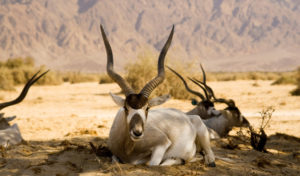Regional insecurity and oil industry activities in the Sahara Desert have pushed the Addax – a migratory species of desert-adapted antelope – to the very knife-edge of extinction, according to a recent survey which found only three surviving in the wild.

An extensive survey in March across key Addax habitat identified just three remaining individuals, report experts from the International Union for Conservation of Nature (IUCN); two of its Members working in the region – the Sahara Conservation Fund (SCF) and the NGO Noé, as well as the Convention on Migratory Species (CMS).
National legislation in Niger fully protects the Addax, meaning hunting and the removal of live Addax for any reason are strictly forbidden. It is also protected under the Convention on Migratory Species (CMS) because historical habitat extends into neighbouring Chad. Yet the Addax has suffered massive disturbance from oil installations in Niger operated by the China National Petroleum Corporation (CNPC) and associated encroachment of desert-going lorries and bulldozers.
Moreover, the assignment of military personnel to protect the oil industry means illegal hunting by soldiers has increased poaching levels considerably in its last remaining haven, and Africa’s largest protected area, the Termit & Tin-Toumma National Nature Reserve in eastern Niger.
Dr Jean-Christophe Vié, Deputy Director of IUCN Global Species Programme says, “We are witnessing in real time the extinction of this iconic and once plentiful species – without immediate intervention, the Addax will lose its battle for survival in the face of illegal, uncontrolled poaching and the loss of its habitat. On behalf of all concerned parties we are recommending a set of emergency measures to help save the Addax from imminent extinction.”
The measures proposed by the experts from the conservation groups* include securing the remaining population of Addax; stopping poaching by soldiers and engaging with CNPC to cooperate on preventing the extinction of the Addax; as well as reinforcing the existing population through the introduction of captive-bred stock.
The increase in poaching also comes against a backdrop of escalating insecurity across the region. The collapse of Libya in 2011 saw an exodus of militia with arms and 4×4 vehicles to neighbouring countries into areas harbouring important wildlife populations. This also fuelled subsequent insurgencies in Mali and northern Nigeria which have added to the instability, and the formerly remote habitats of the Addax have become major crossroads for the illicit trade of wildlife, arms, drugs and migrants.
Dr Thomas Rabeil of the Sahara Conservation Fund says, “Those with commercial interests in the desert could make important contributions to the protection of the Addax by cooperating with the wildlife authorities and by adopting more sensitive practices, becoming stakeholders in the management of protected areas and by sharing sightings of these elusive animals with conservationists.”
The situation for the Addax has deteriorated precipitously since 2010 when an initial round of surveys estimated the population at 200 animals. Since then, conservationists have designed a three-pronged action plan to stabilise the situation by locating the remaining Addax and assessing their status. The plan aims to boost ongoing efforts to build the capacity of Niger’s wildlife service to protect the Addax and manage the Termit & Tin Toumma Reserve in close collaboration with the local population. The third, critical part of the plan is to engage with the Niger authorities and Chinese business interests to bring poaching under control and minimise the impact of oil-related activities, especially on prime Addax habitat.
Arnaud Greth, Chaiman of Noé, says, “Working in coordination with the Ministry of Environment, Noé has focused on reinforcing the capacities of the Management Unit in the Termit & Tin Toumma Protected Area and supporting Niger’s conservation policy to strengthen Addax conservation in the field. But human pressures are increasing faster than we can adapt given the current level of resource support for the Addax and the large distribution range of the Addax in the largest terrestrial protected area in Africa.”
Dr David Mallon, Chair of the IUCN Antelope Specialist Group says, “We are gravely concerned about this unfolding wildlife disaster in the desert. This species is simply unable to cope with the current levels of disturbance and illegal killing. Without urgent coordinated action at all levels we will very soon witness its demise.”
Dr Jean-Christophe Vié, Deputy Director of IUCN’s Species Programme and Director of its SOS initiative, adds, “We have prioritised funding for emergency intervention with the Addax because of the crisis engulfing it. Unfortunately, it is not the only species in the Sahara and Sahel regions under threat from human disturbance, habitat degradation and hunting: Cheetahs, Dama Gazelles and the Slender-horned gazelle are all hot on the heels of this desert icon.
Dr Bradnee Chambers of CMS adds, “The prospect of losing the Addax from the wild is most disturbing. CMS has long been engaged in efforts to conserve Sahelo-Saharan antelopes in cooperation with others such as the European Commission and the Fonds français pour l’environnement mondial. CMS is therefore calling for the support of the leaders of both Niger and Chad to increase the presence of wildlife rangers in key areas and to use their convening powers to bring all stakeholders- including oil companies- together to adopt meaningful action plans to halt the decline of the Addax and associated species before it is too late.”
